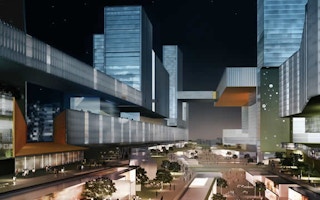Plans for a new eco-city south of Beijing were unveiled on Thursday by former Australian prime minister John Howard.
Located in Langfang in the Hebei province, the 30 square kilometre development will feature a theme park and an exhibition centre, designed to be the world’s largest with over 1.3 million square metres. Green space will flow throughout the development and there will be restrictions on gasoline powered vehicles, according to the developers.
Speaking at the China Asia Pacific Economic Cooperation (APEC) meeting, Mr Howard said, “I am very pleased that Langfang is taking a leadership position in developing smart city technology. This is an outstanding opportunity to build a new city from the ground-up with wired and eco-green technology that will pave the way for cities of the future around the world.”
A representative from global investment company Southworth International, which is developing the project in a joint venture with the privately held Chinese Bestsun (Baichuan) Energy Group, told Eco-Business they would be using “cutting-edge technology in energy, transportation, low carbon, water and wired infrastructure in the recreational business district and residences.”
The joint venture, dubbed the SunWorth Development Group, has not yet determined which technologies will be included in the project but transportation technologies will be a major consideration, said Southworth International’s Ted Phillips. He added that the group was exploring options including personal pod vehicles and a monorail system. In addition, he said that all loading and unloading for the exhibition centre will take place underground.
SunWorth has engaged a number of international consultants to determine the technologies for the project, including global engineering and planning firm Arup, the United States-based convention centre planning group Conventional Wisdom, New York head-quartered green building architects Kohn Pedersen Fox and the consulting arm of the United Kingdom-based Birmingham Institute of Art and Design (BIAD).
The Chinese government has invested billions of dollars toward regional infrastructure in the region, referred to as the Beijing-Tianjin Growth Corridor, in expectation of an anticipated rise of nearly 300 million people from poverty to middle class over the next 20 years.
Sunworth’s project is one of a growing number of eco-city developments awarded by the Chinese. In February an Italian group was awarded the Eco Nanhe Town project, which will include a science park in addition to commercial and community facilities for 75,000 people in Tianjin. Also in Tianjin is the high profile Sino-Singapore Tianjin Eco-city project to be completed by 2020 with a projected population of 350,000.
Eco-cities, which aim to provide models for sustainable urban living, have drawn criticism in the past for failing to deliver due to lack of local planning and confusion concerning funding. The most infamous example was the Dongtan community planned on the outskirts of Shanghai, which is described in a 2009 report in Yale Environment 360.
Other eco-city sceptics would rather see investments into making China’s existing cities more sustainable. With about 666 million Chinese already living in cities, according to the latest census, the nation is seeking ways of reducing the carbon footprint of its existing urban centres.
One initiative addressing this need is the China Redesign programme. Developed by international non-profit organisation The Climate Group, the China Redesign project will work with five cities to design and execute a low-carbon development plan for an initial period of three years. Launched in March, its aim is to help those cities reduce their energy intensity, or energy consumption per unit of GDP, in line with China’s national target of 16 per cent.
Investment in technology and the corresponding infrastructure is a concern for both old and new cities. A 2010 report by the state think-tank China Development Research Foundation stated that Beijing along would need to invest up to 3.6 trillion dollars in urban infrastructure by 2020.
Some of that investment will be for Beijing’s new Capital Airport, to be completed in 2016 four miles from the Langfang eco-city. As the world’s largest airport, it will feature an extensive transport system that connects the airport and Langfang’s new convention centre with Beijing.
The transport technologies chosen for the eco-city will be part of that network. For those and other technologies utilised in the eco-city, according to Southworth International’s Mr Phillips, they intend to use currently available cutting edge technology, “as well as adopting technology that is not commercially available yet, but is emerging.”










